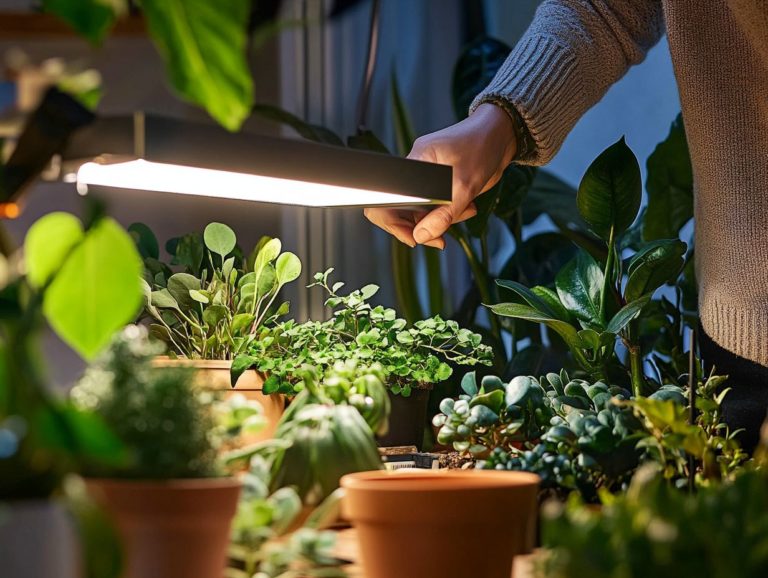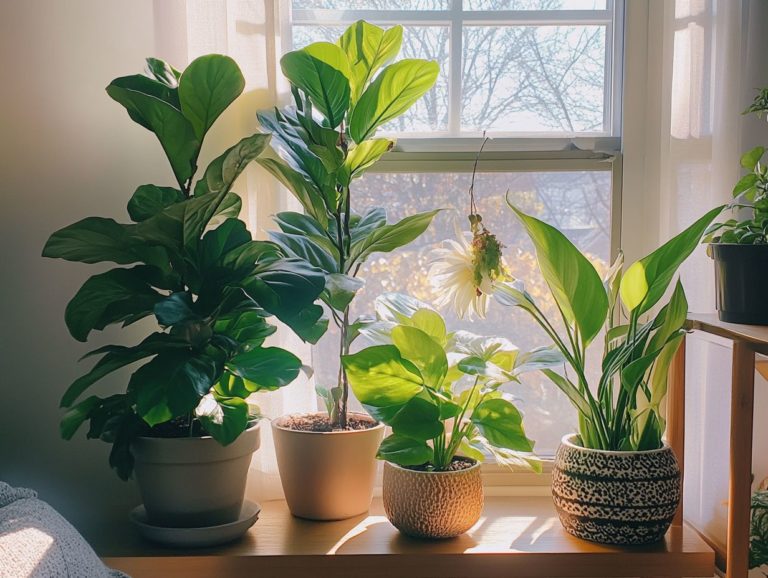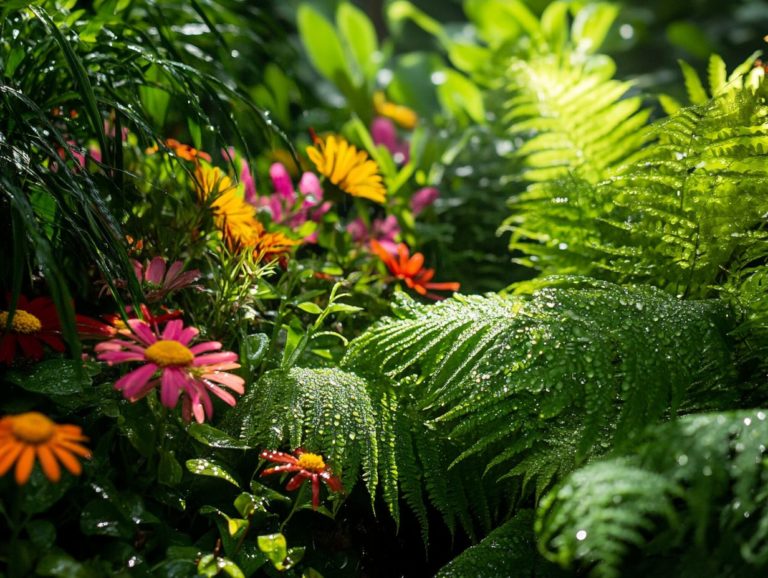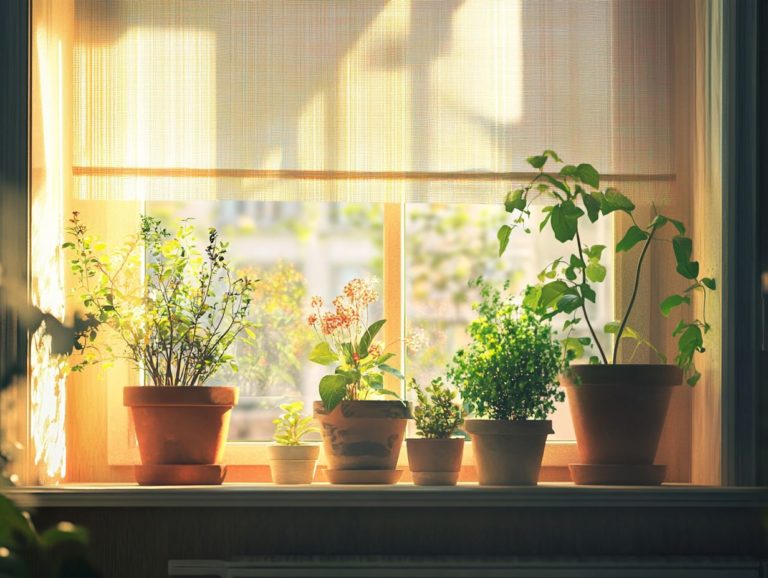The Connection Between Light and Growth Rates
Light is essential for plant growth, acting as the vital energy source that fuels photosynthesis, the process plants use to make food from sunlight.
Understanding how light affects growth rates is crucial for you as a gardener or horticulturist. This article delves into light intensity, duration, spectrum, and quality, providing valuable insights on optimizing these elements for different plant types.
It also highlights the problems caused by insufficient light and offers practical strategies to enhance your growing conditions.
Discover how to unlock the full potential of light to grow thriving plants!
Contents
Key Takeaways:
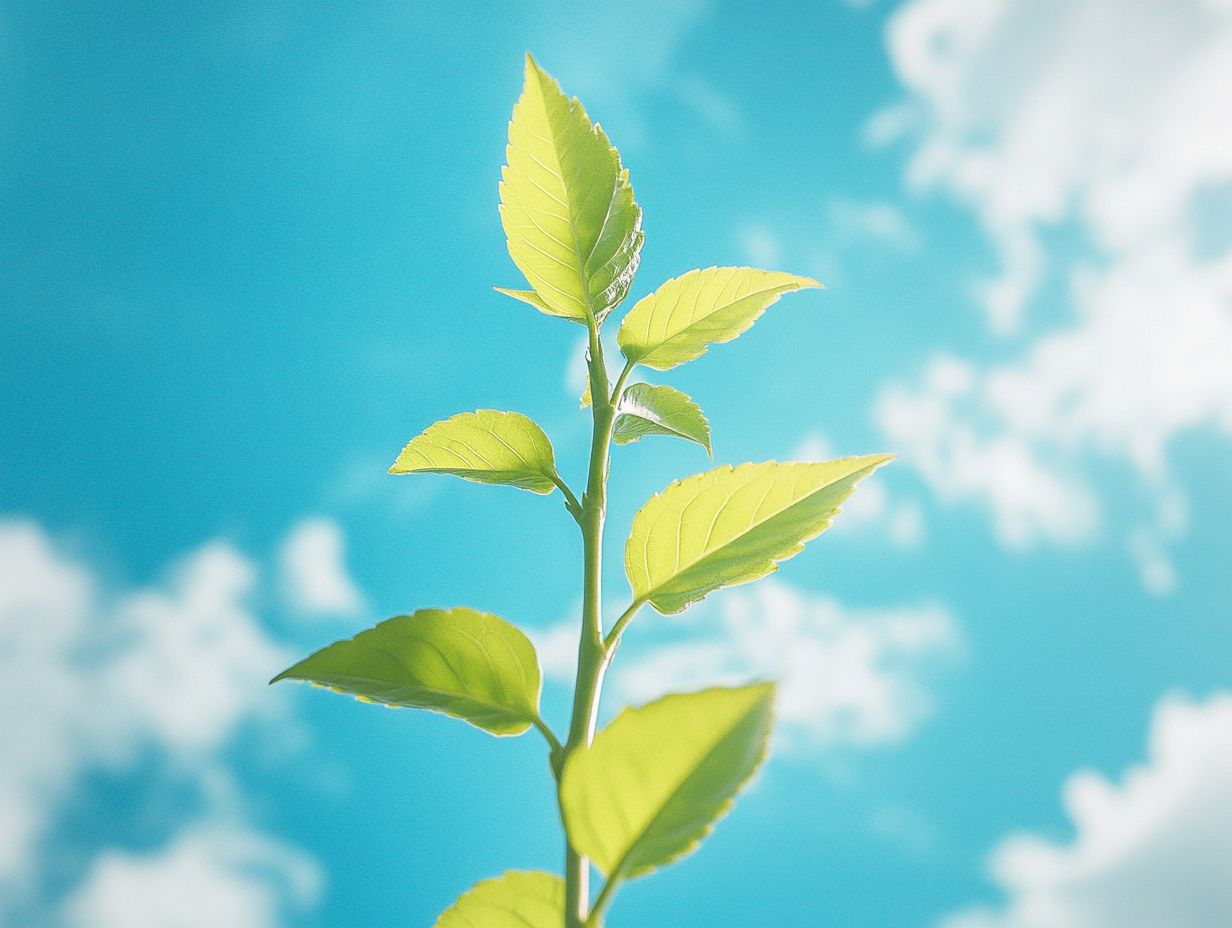
- Light is essential for plant growth, serving as the main energy source for photosynthesis.
- Light intensity, duration, and quality can greatly affect growth, and different plants have unique light needs.
- Ensure the right light source and adjust it for your plants to prevent stunted growth.
The Role of Light in Plant Growth
Light serves as a fundamental force in plant growth. It orchestrates the process of photosynthesis, allowing plants to transform light energy into chemical energy, which is vital for their survival and development.
The quality, intensity, and duration of light exposure play critical roles in influencing various plant species. These factors affect everything from the amount of plant material produced to overall growth performance.
Understanding the intricate relationship between light and plants is essential for optimizing growth conditions, whether in outdoor gardens or indoor facilities.
Understanding Photosynthesis
Photosynthesis is the remarkable process through which plants convert light energy into chemical energy. Utilizing chlorophyll, plants capture sunlight and transform carbon dioxide and water into glucose and oxygen.
This intricate mechanism relies on the absorption of specific light wavelengths that are vital for chlorophyll to effectively harness energy from the sun. Different plant species have evolved various types of chlorophyll, allowing them to thrive in a range of environmental conditions, from vibrant rainforests to arid deserts.
During this energetic transformation, plants engage in gas exchange (the process of taking in carbon dioxide and releasing oxygen), which plays a pivotal role in maintaining the ecosystem. Factors such as temperature, humidity, and light intensity can significantly influence the efficiency of photosynthesis, directly impacting how well plants produce energy for growth and survival.
Factors Affecting Growth Rates
Several factors influence your plants’ growth rates, with environmental elements like light intensity, temperature, and nutrient availability being essential for optimizing performance across different species.
By understanding how each of these factors interacts, you can gain valuable insights into the physiological processes that drive biomass allocation and hormonal regulation in plants.
Tailoring growth treatments to specific species can further boost their growth rates and overall health, ensuring your gardening efforts yield the best results.
Light Intensity and Duration
Light intensity and duration play pivotal roles in shaping plant growth. They profoundly influence photosynthesis rates and overall growth attributes, particularly regarding biomass production and plant health.
When plants receive sufficient light, they can effectively perform photosynthesis, transforming carbon dioxide and water into glucose and oxygen both vital for their development. Different light intensities evoke unique responses. For instance, shade-loving species flourish in lower light conditions, while sun-loving varieties can become leggy or weak if deprived of adequate light.
Extending exposure to optimal light conditions fosters vigorous growth and maximizes yields, especially when paired with appropriate temperature ranges. By grasping these dynamics, you can cultivate environments tailored to meet specific plant needs, ultimately enhancing your crop productivity.
Act now to optimize your plants’ growth!
Light Spectrum
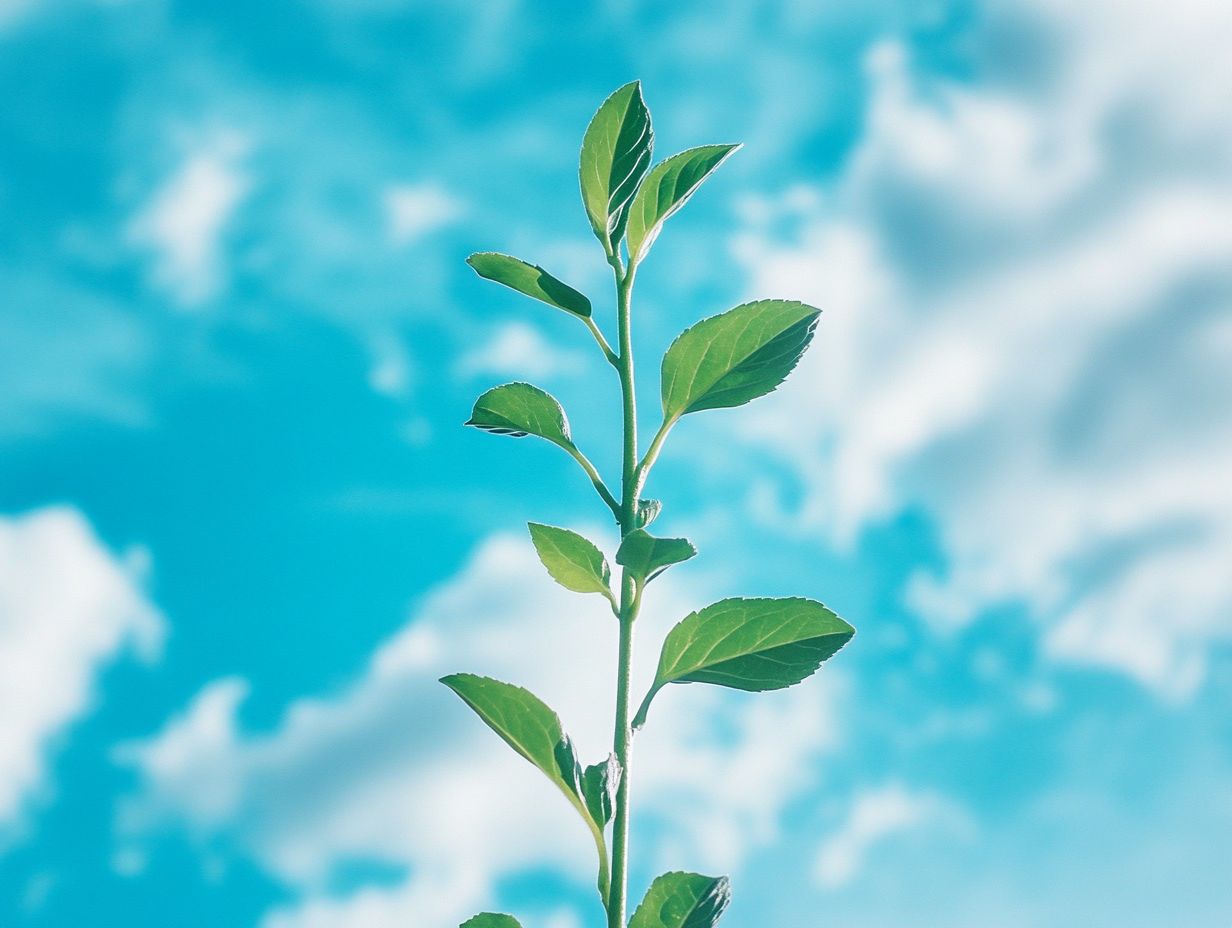
The light spectrum, which includes various wavelengths, is crucial for photosynthesis. It influences the absorption of chlorophyll and other pigments in plants, impacting their growth and development.
Each wavelength corresponds to different energies. For example, blue light with its shorter wavelengths is essential for vegetative growth and stimulating leaf development. In contrast, red light encourages flowering and fruiting stages.
Other pigments, such as carotenoids and anthocyanins, respond to specific light conditions, contributing to the overall health and resilience of the plant.
By understanding these interactions, you can optimize light conditions to enhance photosynthesis and promote robust growth across various plant species.
Light Quality
Light quality means the specific wavelengths of light you provide to your plants. It can significantly influence their growth performance.
It affects not only making chlorophyll but also energy conversion and hormonal regulation of various physiological processes.
Different wavelengths impact several aspects of plant physiology, including root and shoot development, leaf expansion, and overall biomass accumulation (the total mass of living plants).
For instance, blue light plays a crucial role in synthesizing chlorophyll, boosting its concentration to optimize energy for photosynthesis. Meanwhile, red light affects flowering and fruiting through hormonal signaling, influencing growth cycles and yield.
Light quality doesn’t operate in isolation; it interacts with other environmental factors, creating a complex web of influences. This interplay determines how effectively your plants can harness energy, shaping their health and productivity.
Optimizing Light for Growth
Creating the perfect light for your plants can lead to amazing growth! This involves carefully selecting the right light sources tailored to the specific needs of different plant types.
Implementing effective growth treatments in both indoor and outdoor settings is also essential. By focusing on these details, you can create an ideal environment that fosters healthy, vibrant plants.
Choosing the Right Light Source
Selecting the right light source is essential for maximizing photosynthesis and promoting optimal plant growth, especially in indoor settings where natural sunlight may be limited.
Understanding the different types of artificial light sources can profoundly influence the overall health and productivity of your indoor plants. Some options include:
- LED lights: Energy-efficient and emit specific wavelengths that plants absorb, enhancing photosynthetic activity.
- Fluorescent lights: A balanced compromise between initial costs and energy use, popular among indoor gardeners.
- High-intensity discharge (HID) lighting: Offers substantial light output with higher energy consumption, suitable for larger setups.
Each lighting option impacts energy efficiency and plays a pivotal role in growth rates, flowering, and fruiting. Choose the lighting that best meets the specific needs of your plants!
Explore different lighting solutions to find what works best for your plants!
Adjusting Light for Different Plant Types
Adjusting light conditions to cater to the specific needs of various plant types is essential for fostering optimal growth and ensuring that physiological processes thrive.
Every plant species has unique light requirements. These include light intensity, duration, and quality, which are important for their growth. For instance, shade-loving varieties thrive in reduced light, while sun-loving plants crave bright, direct sunlight to effectively harness energy. By grasping these distinctions, you can craft a personalized lighting regimen that not only supports photosynthesis but also enhances the flowering and fruiting phases.
Using the right light spectrums can truly transform your plants health! Specific light spectrums can impact hormone production and nutrient absorption, directly influencing the overall health and vitality of your plants. Understanding these unique needs enables you to manage growth environments more effectively, ultimately leading to flourishing gardens and healthier plants.
Effects of Insufficient Light on Growth
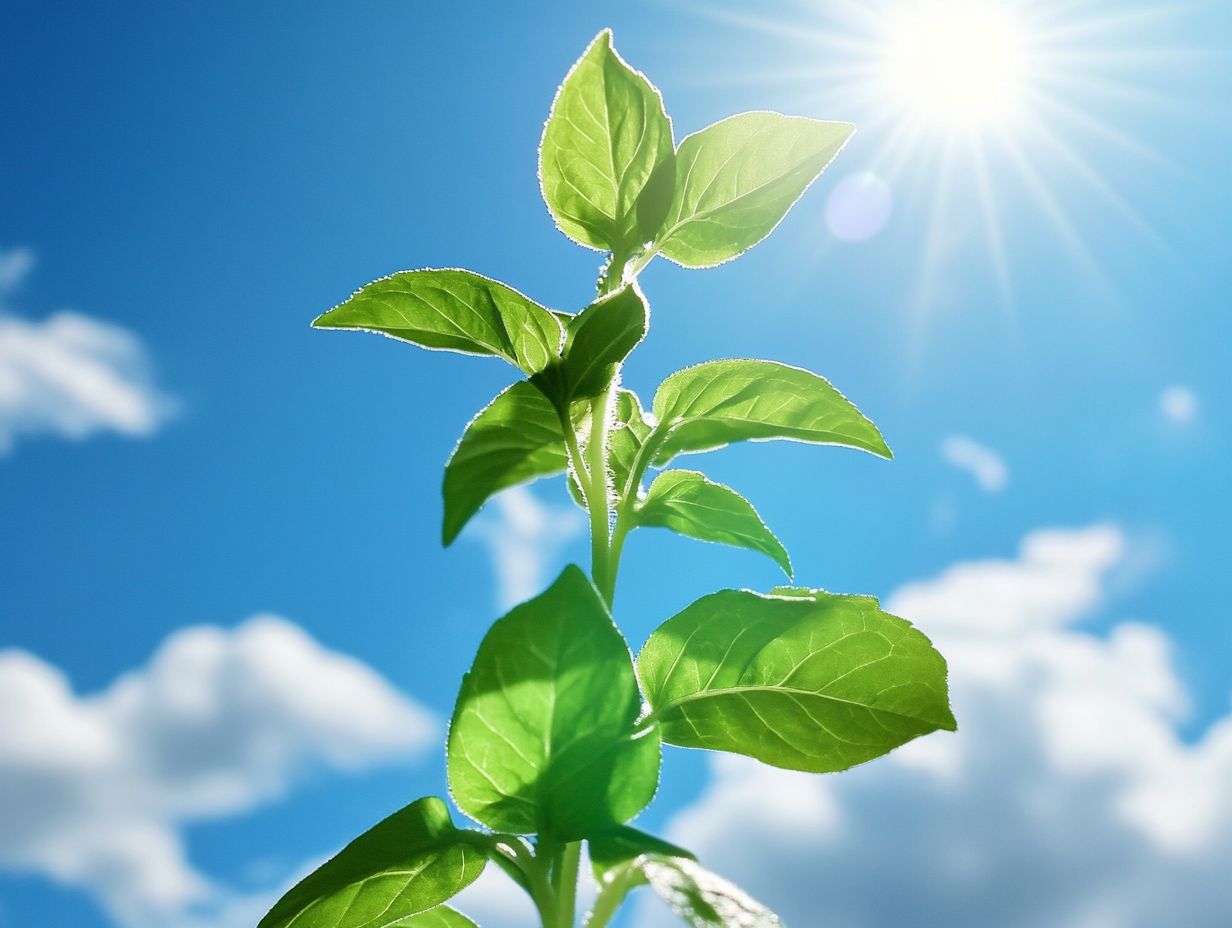
Insufficient light can significantly hinder your plants’ growth, ultimately resulting in stunted growth rates, reduced biomass, and compromised physiological processes such as how plants use energy when there is no light and gas exchange.
Ensuring adequate lighting is crucial for fostering a thriving garden or indoor plant collection.
Signs of Light Deficiency
Signs of light deficiency in your plants can show up in various ways. You might notice the leaves turning yellow due to reduced chlorophyll production, stunted growth, or a decrease in overall biomass.
Take the tomato plant, for example. When it doesn t get enough light, it tends to stretch its stems toward any available light sources, a phenomenon known as etiolation. Similarly, if you re growing leafy greens like spinach, watch for limp, pale leaves they’re a clear indication that the plant lacks the energy needed for optimal chlorophyll synthesis.
Flowering plants, such as marigolds, may disappoint with fewer blooms or delayed flowering when light is scarce, impacting their overall health and biomass. These signs aren’t just individual reactions; they highlight the essential role that adequate lighting plays in ensuring your plants thrive and reach their full potential.
Strategies for Improving Light Conditions
Implementing effective strategies to improve light conditions is essential for enhancing your plants’ health and promoting optimal growth through targeted treatments and environmental adjustments.
By thoughtfully considering both artificial lighting solutions and natural light sources, you can create an environment that truly supports plant vitality. Options like LED grow lights offer specific wavelengths that cater directly to photosynthesis, while adjusting plant positioning can maximize their exposure to sunlight throughout the day. Understanding the connection between light and water needs is also crucial for optimal growth.
Incorporating reflective materials in the room boosts light quality, ensuring your plants receive the energy they need. Exploring various spectrum choices and timers for artificial lights can also lead to significant improvements in growth patterns, resulting in healthier and more productive plants overall.
Frequently Asked Questions
Here are some common questions about how light affects plant growth.
What is the connection between light and growth rates?
The connection between light and growth rates refers to the relationship between the amount of light a plant receives and the rate at which it grows. Light is essential for photosynthesis, a process in which plants use light energy to convert water and carbon dioxide into glucose and oxygen. The more light a plant receives, the more efficiently it can carry out photosynthesis, leading to faster growth rates.
How does light affect plant growth?
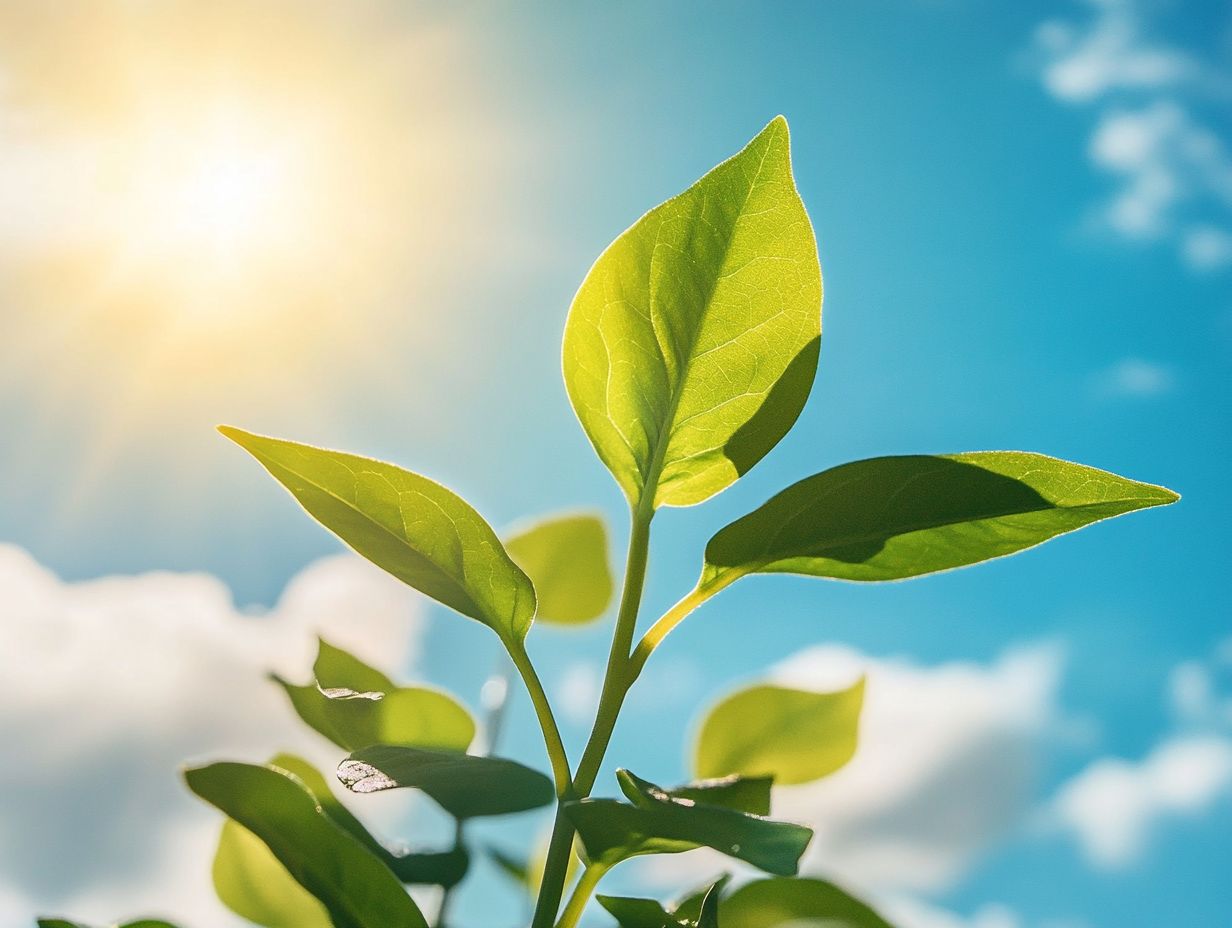
Light affects plant growth in several ways. It plays a crucial role in photosynthesis, which is the primary source of energy for the plant. Light also affects a plant’s production of hormones, such as auxin, which helps plants grow taller, and gibberellin, which assists with flowering. The intensity and duration of light exposure can also impact a plant’s flowering and fruiting processes.
Can plants grow without light?
No, plants cannot grow without light! Light is essential for photosynthesis, which gives plants the energy they need to survive.
What happens if a plant doesn’t receive enough light?
If a plant doesn t get enough light, it will struggle with photosynthesis. This leads to slow growth and may make the plant weak and spindly.
Is there such a thing as too much light for plants?
Yes, too much light can harm plants. While light is necessary, excessive amounts can damage leaves and prevent nutrient absorption.
How can I optimize the amount of light for my plants’ growth?
To optimize light for your plants, understand their specific needs. Different plants have different light tolerances.
Provide enough light for photosynthesis, but avoid excessive amounts that could harm them. Monitor their growth to make adjustments, like moving them to a sunnier or shadier spot.

